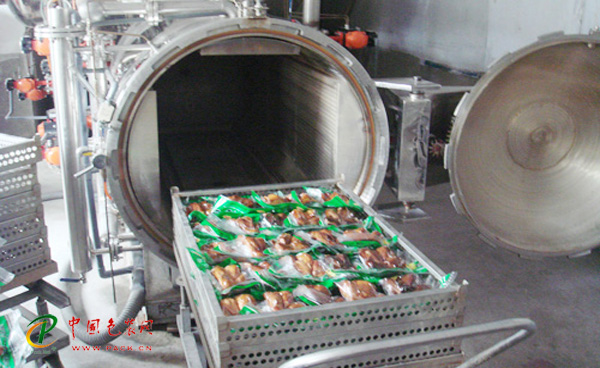[China Packaging Network News] Food safety is a systematic project that requires the coordination of manual sterilization and automatic mechanical sterilization in order to ensure the safety and hygiene of food packaging. If you use the white plus black cold medicine as a metaphor, use dynamic food sterilizers and clean room dynamic sterilizers during the day. Use ultraviolet and ozone at night to control the secondary pollution of bacteria-containing air.
The sterilizer is a very important equipment in the food packaging industry. The sterilizer kills the microorganisms on the products, packaging materials, packaging aids, and packaging components to within the allowable range. The sterilizer is a continuous sterilizing process for fruit and vegetable puree, raw juice, concentrated juice, milk, juice drinks or similar products. The main drive component of the sterilizer is the feed pump, which is used to transfer material to ensure safe operation of the equipment. KSB's Etabloc and Etachrom are used as supporting pumps for sterilizers. They have the advantages of high work efficiency, low energy consumption, and low maintenance costs.

Two major tools for sterilization of food packaging: drug sterilization and UV sterilization
Sterile packaging includes the sterilization and sterilization of packaging materials, the sterilization of packaging contents and the sterilization of packaging environments. At present, the commonly used sterilization methods for packaging materials include drug sterilization and ultraviolet sterilization, which can be said to be two major tools for the sterility of food packaging.
Food packaging workshop sterilization equipment into food safety "Guardian"
1. The bactericide used in drug sterilization must be a drug with strong sterilizing ability, no corrosion to the equipment, no harmful substances in the sterilizing process, and less residue in the packaging material.
At present, the most commonly used bactericide is hydrogen peroxide, which is generally referred to as hydrogen peroxide. The bactericidal capacity of hydrogen peroxide is related to its concentration and temperature, and the higher the concentration and the higher the temperature, the better its ability to sterilize. Hydrogen peroxide, which is commonly used for sterilization, has a concentration of 25% to 30% and a temperature of 60 to 65 degrees Celsius. Sterilization with hydrogen peroxide should be combined with heat treatment because hydrogen peroxide will have better bactericidal efficacy when it is heated to evaporate from the surface of the material.
To sterilize the packaging containers with hydrogen peroxide, the packaging containers are immersed in hydrogen peroxide or directly sprayed on the packaging containers for sterilization, and then they are heat-radiated so that the hydrogen peroxide remaining on the packaging containers is completely evaporated together with the hot air. Decomposes into harmless water vapor and oxygen.
Secondly, in general, the sterilization effect of ultraviolet light is related to the wavelength, irradiation degree, and irradiation time of ultraviolet light, and the wavelength is most intense at about 250 to 360 nm.
The principle of ultraviolet sterilization is mainly because the nucleic acid in the microbial cells in the ultraviolet radiation produces a chemical reaction, which causes the metabolic disorder of the microorganism and causes it to lose its ability to proliferate. Ultraviolet sterilization is one of the more effective methods for aseptic packaging or clean packaging. It has the advantages of non-residues, high safety, easy use, and low cost. However, compared with hydrogen peroxide, its bactericidal effect is not very good, and it should generally be used in combination with other methods of sterilization.
Food production workshop; good effect of dynamic sterilization equipment
At present, there are a variety of domestic food sterilization and disinfection industries, and various types of sterilization methods are applied to different food production enterprises. Incidental food companies mainly choose ultraviolet light irradiation sterilization, drug spray sterilization, ozone sterilization for sanitation, all belong to the static sterilization method, in which ultraviolet light irradiation sterilization and ozone sterilization can play a certain degree of extinction. Bacteria effect, but there are certain defects, many external factors, such as the impact of ozone sterilization factors are humidity, temperature, fresh air, ozone generation, ozone sterilization time; UV lamp life is shorter. More or less affected the sterilization effect of food companies.
Dynamic disinfection products are harmless to the human body. When someone is working, they can simultaneously disinfect and disinfect the inner packaging workshop, prevent the food to be packaged exposed in the environment from being contaminated by bacteria, and improve the food safety.
According to the industry, the technology is mainly used in food cooling and packaging workshops. The food processed by high temperature during cooling and packaging is also in direct contact with the air in the workshop. The air containing more bacteria attaches to the surface of the food. Contaminating the food again will cause the food to deteriorate in the future.
Some food production companies have adopted the latest NICOLER dynamic sterilization technology - food dynamic sterilization machine, the sterilization process is: high pressure pulse makes NICOLER sterilization chamber generates a lot of plasma. Under the action of the negative pressure blower, when bacteria-containing air passes through the sterilization chamber, the bacteria is instantaneously decomposed, and the three-layer sterilization chamber is gradually advanced to ensure the sterilization effect. Recombinate the nano-materials for secondary sterilization and filtration to keep the environment sterile and dust-free. When sterilizing, people can work in the workshop at the same time, so this machine is called a dynamic sterilizer.
Application practice shows that after opening one food dynamic sterilizer in an inner packaging of 60 square meters for one hour, the air sedimentation bacteria in the workshop is ≤ 15 CFU/dish. 30 minutes, planktonic bacteria ≤ 500/m3. The long service life of the equipment and the purchase of the equipment at a lower price enable the simultaneous concept of side-by-side operation and side disinfection, and keeps the food shop clean.
